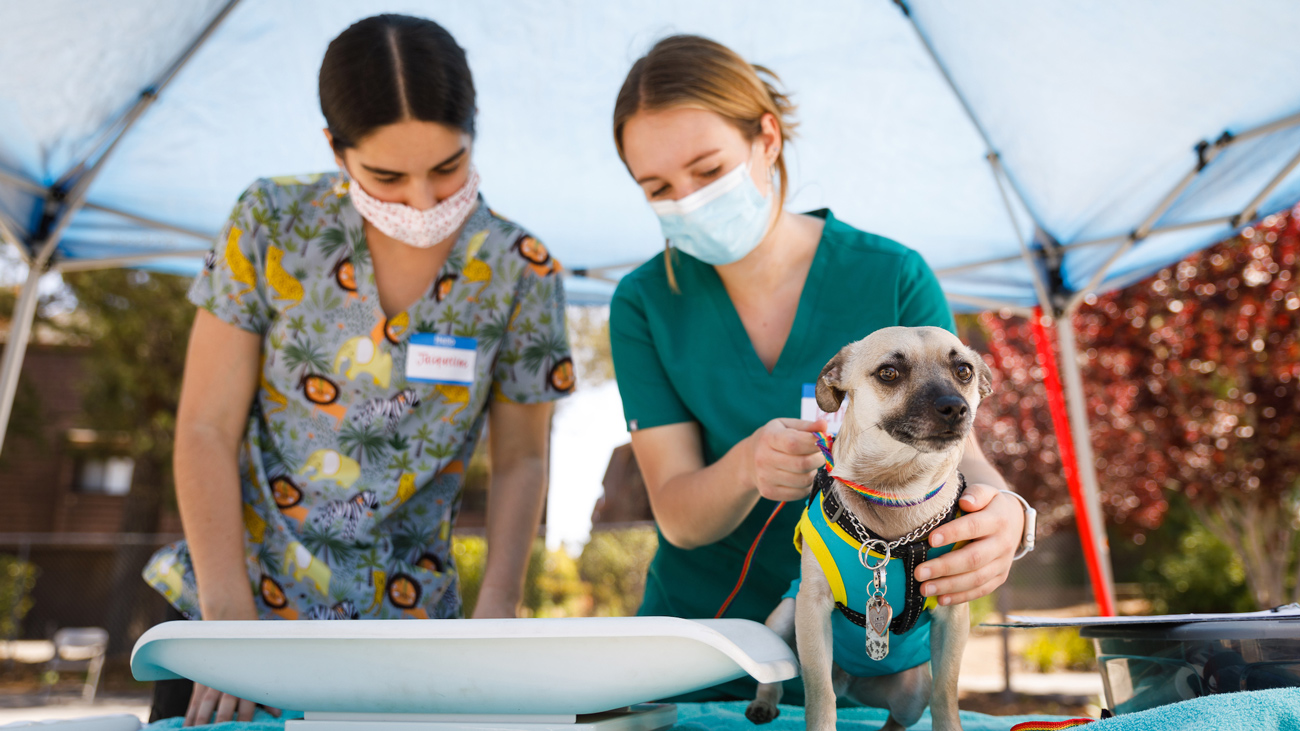I think I’ve always known I wanted to be a veterinarian.
Having grown up with a menagerie of rescued companion and exotic animals — from reptiles (geckos, tortoises and snakes) to dogs, cats, and horses — it’s been a lifelong dream to advocate for and take care of animals.
The isolation brought on by the COVID-19 pandemic brought new challenges to education, and I’ve missed being able to work in teams with fellow students and professors within Cal Poly’s enterprise programs. These in-person enterprises are what made the school so compelling and help me learn in unique ways. It’s been exciting to get back into these real-world learning experiences.
 Recently I’ve been able to combine my experience and dedication to animals through the Cal Poly Veterinary Community Service Enterprise. Joining a team of about 15 students, we set up veterinary care clinics for San Luis Obispo community members experiencing houselessness or low-income conditions. We provide a range of animal care, including flea and tick prevention, vaccinations, deworming, heartworm tests/prevention, as well as the occasional sedation procedures.
Recently I’ve been able to combine my experience and dedication to animals through the Cal Poly Veterinary Community Service Enterprise. Joining a team of about 15 students, we set up veterinary care clinics for San Luis Obispo community members experiencing houselessness or low-income conditions. We provide a range of animal care, including flea and tick prevention, vaccinations, deworming, heartworm tests/prevention, as well as the occasional sedation procedures.
On Fridays, our team verifies our field supplies to ensure we have sufficient vaccines and preventative medicines on hand at the clinic. Saturdays are our clinic days, where all the real work happens. We split up into groups to work an exam table with an animal, prepare the necessary supplies for each patient, or check in on clients and their animals. We get to learn from Dr. Jennifer Staniec, a licensed veterinarian and our course’s instructor.
For me, this community enterprise has already been an ideal Learn by Doing experience that will continue to help me increase my technical veterinary and communication skills. Informing the clients of proper animal care procedures is a helpful and rewarding function of the clinic. Our clients have very close relationships with their pets and demonstrate how precious the human/animal bond can be.
 I’ve really enjoyed connecting with community members and understanding the challenges of finding good care for their animals. Our clients show great appreciation for the service. For instance, at the first clinic I met Jorge and his chihuahua, Olivia. He was so pleased that we were able to help care for his dog that he invited us to his restaurant — and gave us free appetizers and a hug!
I’ve really enjoyed connecting with community members and understanding the challenges of finding good care for their animals. Our clients show great appreciation for the service. For instance, at the first clinic I met Jorge and his chihuahua, Olivia. He was so pleased that we were able to help care for his dog that he invited us to his restaurant — and gave us free appetizers and a hug!
I’ve been lucky to have other opportunities to learn from veterinary practices away from Cal Poly too. During summer breaks and vacations, I’ve worked at Bressi Ranch Pet Hospital, a modern veterinary clinic in Carlsbad, California, to learn the inner workings of a companion animal hospital and assist with examinations, laser therapy treatments, and dental procedures. Working closely with several small animal veterinarians, I’ve developed a great respect for their diagnostic skills and animal insights. Plus, they’ve also helped me with the human side of companion animal care.
Two years ago, I spent a month volunteering in a cheetah sanctuary in Paarl, South Africa. While helping care for the cheetahs, I learned how veterinarians design unique medical plans for special-needs or sick cheetahs, paying close attention to their dietary, physical, and social requirements. The deep bond between those big cats and their caretakers drew me further into the love of veterinary medicine.
Experiences like these and the Cal Poly Veterinary Community Enterprise allow me to further my dream of advocating for animals. It’s also helping me prepare me for the next step on my journey after Cal Poly: the Cal Poly/University of Glasgow’s Feepass Veterinary School program where I’ll be starting in 2022.



